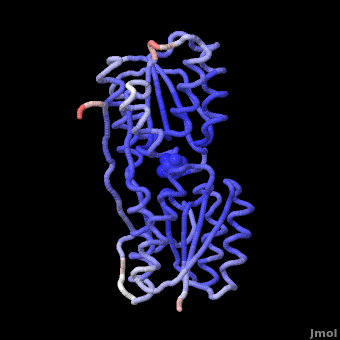Ribose-binding protein
From Proteopedia
(Difference between revisions)
(New page: {{STRUCTURE_2fn8| PDB=2fn8 | SIZE=400| SCENE= |right|CAPTION=Ribose-binding protein complex with ribose, 2fn8 }} '''Ribose-binding protein''' (RBP) is a component of a high-affinity...) |
|||
| (6 intermediate revisions not shown.) | |||
| Line 1: | Line 1: | ||
| - | + | <StructureSection load='' size='350' side='right' scene='Journal:JBSD:22/Cv/2' caption=''> | |
| - | + | ||
'''Ribose-binding protein''' (RBP) is a component of a high-affinity transport system for ribose. RBP is a receptor for chemotaxis toward ribose. RBP is exported by the cell’s secretion pathway. For more details see [[Molecular Playground/RBP]]. | '''Ribose-binding protein''' (RBP) is a component of a high-affinity transport system for ribose. RBP is a receptor for chemotaxis toward ribose. RBP is exported by the cell’s secretion pathway. For more details see [[Molecular Playground/RBP]]. | ||
| - | + | === Molecular dynamics simulations of the thermal stability of tteRBP and ecRBP <ref>doi 10.1080/07391102.2012.721497</ref>=== | |
| + | The ''Thermoanaerobacter tengcongensis'' ribose binding protein (tteRBP) and ''Escherichia coli'' ribose binding protein (ecRBP) are both members of the periplasmic binding protein (PBP) superfamily. PBP play many roles in prokaryotic ABC transport, chemotaxis and intercellular communication systems. The backbone structure of tteRBP (optimal activity temperature is 375 K, <span style="color:yellow;background-color:black;font-weight:bold;">colored in yellow</span>) and ecRBP (optimal activity temperature is 329 K, (<span style="color:violet;background-color:black;font-weight:bold;">colored in violet</span>) <ref name="Matthew">PMID:18373848</ref> is <scene name='Journal:JBSD:22/Cv/12'>very similar</scene>, but significantly <scene name='Journal:JBSD:22/Cv/2'>different in thermal stability</scene>. | ||
| + | In order to investigate the thermal stability of <scene name='Journal:JBSD:22/Cv/9'>tteRBP</scene> (<span style="color:violet;background-color:black;font-weight:bold;">crystal structure ([[2ioy]]) is in violet</span>, <font color='magenta'><b>tteRBP under the room temperature (300 K) is in magenta</b></font>, <font color='darkmagenta'><b>tteRBP under the optimal activity temperature (375 K) is in darkmagenta</b></font>) and <scene name='Journal:JBSD:22/Cv/14'>ecRBP</scene> (<span style="color:yellow;background-color:black;font-weight:bold;">crystal structure ([[2dri]]) is in yellow</span>, <span style="color:orange;background-color:black;font-weight:bold;">ecRBP under the room temperature (300 K) is in orange</span>, <span style="color:chocolate;background-color:black;font-weight:bold;">ecRBP under the optimal activity temperature (329 K) is in chocolate</span>) molecular dynamics simulations were performed for investigating the dynamics changes of the two proteins. The results show that the overall structures of the ecRBP and tteRBP are well maintained at the two temperatures, respectively. The radius of gyration, solvent accessible surface area, salt bridges, side-chain interactions and hydrogen bonds of the two proteins are almost unchanged at the different temperatures, their conformations also have no obvious changes, moreover, the RMSIP reflect that the overall motion of tteRBP or ecRBP move along the same direction of the essential fluctuations at the different temperatures, respectively. The further analysis shows that the tteRBP and ecRBP both have strong side-chain interactions to maintain structural stability at the high temperatures, and they have different patterns of the intramolecular motion and flexibility at the two temperatures. At room temperature and the optimal activity temperature, the <scene name='Journal:JBSD:22/Cv/10'>tteRBP has higher flexibility</scene> and <scene name='Journal:JBSD:22/Cv/15'>more high flexible regions</scene> (<font color='darkmagenta'><b>tteRBP under the optimal activity temperature (375 K) is in darkmagenta</b></font> with <span style="color:green;background-color:black;font-weight:bold;">highly flexible regions colored in green</span> and <span style="color:chocolate;background-color:black;font-weight:bold;">ecRBP under the optimal activity temperature (329 K) is in chocolate</span> with <span style="color:lime;background-color:black;font-weight:bold;">highly flexible regions colored in lime</span>) than the <scene name='Journal:JBSD:22/Cv/16'>ecRBP</scene>. These are the most differences between tteRBP and ecRBP. So the higher flexibility of tteRBP 375 K has more advantageous to maintain overall structure stability and adapt to high temperature by the fine-tune structure with higher flexibility. According to article of Matthew ''et al''., (2008)<ref name="Matthew">PMID:18373848</ref> we can conclude that the strong side-chain interactions and flexibility of backbone both are the key factors to maintain thermal stability of the two proteins. | ||
| + | </StructureSection> | ||
| + | __NOTOC__ | ||
== 3D Structures of Ribose-binding protein== | == 3D Structures of Ribose-binding protein== | ||
| - | + | Updated on {{REVISIONDAY2}}-{{MONTHNAME|{{REVISIONMONTH}}}}-{{REVISIONYEAR}} | |
| - | + | {{#tree:id=OrganizedByTopic|openlevels=0| | |
| - | + | ||
| - | + | ||
| + | *Ribose-binding protein | ||
| - | + | **[[1dbp]], [[1drj]], [[1drk]], [[1urp]] – EcRBP – ''Escherichia coli''<br /> | |
| + | **[[1ba2]], [[2gx6]] – EcRBP (mutant)<br /> | ||
| + | **[[1ogc]] – BsRBSD – ''Bacillus subtilis''<br /> | ||
| - | + | *Ribose-binding protein with ligand | |
| - | + | ||
| - | + | ||
| - | + | ||
| - | + | ||
| + | **[[2dri]] - EcRBP + ribose<br /> | ||
| + | **[[1ogd]] – BsRBSD + ribose<br /> | ||
| + | **[[1oge]] – BsRBSD + ribose-5-phosphate<br /> | ||
| + | **[[1ogf]] – BsRBSD + glycerol<br /> | ||
| + | }} | ||
| + | '''References''' | ||
| + | <references/> | ||
[[Category:Topic Page]] | [[Category:Topic Page]] | ||
Current revision
| |||||||||||
3D Structures of Ribose-binding protein
Updated on 13-September-2018
References
- ↑ Feng XL, Zhao X, Yu H, Sun TD, Huang XR. Molecular dynamics simulations of the thermal stability of tteRBP and ecRBP. J Biomol Struct Dyn. 2012 Oct 2. PMID:23025251 doi:10.1080/07391102.2012.721497
- ↑ 2.0 2.1 Cuneo MJ, Tian Y, Allert M, Hellinga HW. The backbone structure of the thermophilic Thermoanaerobacter tengcongensis ribose binding protein is essentially identical to its mesophilic E. coli homolog. BMC Struct Biol. 2008 Mar 28;8:20. PMID:18373848 doi:10.1186/1472-6807-8-20

